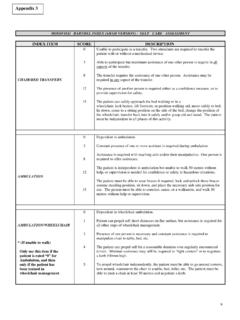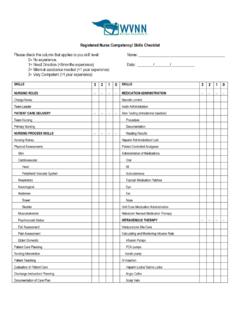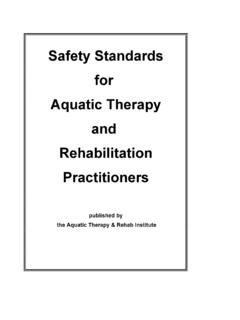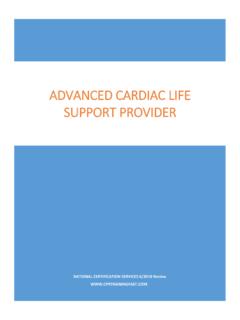Transcription of CLINICAL MAPPING TOOL - Functional Pathways
1 CLINICAL MAPPING TOOLT herapy CLINICAL Care Pathway245 CLINICAL MAPPING tool Procedure Safe Transition Planning tool Benchmarking8 CLINICAL Outcome Tracking Form910 Pathways to Success CLINICAL Care Pathways1215182124273033363942444649 Acute respiratory FailureCongestive Heart Failure (CHF)Chronic Obstructive Pulmonary Disease (COPD) Medically ComplexMyocardial Infraction (MI)CardiacCerebrovascular Accident (CVA)Neuro - DegenerativeSpinal Cord / Brain InjuryHipKneeShoulderOrtho - OtherPneumoniaRenal / Urinary52 Grand Rounds Policy5556 Forms5859 Interdisciplinary Review SheetNursing to Therapy Referral Form Therapy Screen FormShort Term Goal Bank60 Table of Contents 4 Back to Table of ContentsTo ensure the delivery of elite therapy, Functional Pathways CLINICAL MAPPING tool serves as a care pathway to enhance the quality of care and consistently achieve optimal outcomes.
2 The outcomes determined by the CLINICAL MAPPING tool align with Functional Pathways communication software RightTrack -- which provides community staff, physicians, and family members the ability to track patients progress. The CLINICAL MAPPING tool follows a seven-step process that serves as a framework for determining the most clinically appropriate pathway for the MAPPING tool Procedure1)DiagnosisIdentify the primary diagnosis impacting Functional performance and refer to the diagnosis specific CLINICAL Care )OutcomesInclude the outcomes listed for each diagnosis in RightTrack on the initial )Therapy GoalsReview the general goals for the diagnosis specific CLINICAL Care Pathway to assist with setting goals based on prior level of function, current deficits, underlying impairments, and discharge )
3 Recommended PathwaysSelect the appropriate Pathway to Success and the supporting CLINICAL programs. 5)InterventionsSelect medically necessary treatment interventions and billing )Re-EvaluationRe-evaluation may be necessary if the patient does not follow an expected path to recovery. If re-evaluation is indicated, refer back to Steps 3 and 4 in the CLINICAL MAPPING )DischargeSafe Transition Planning should begin with the initial evaluation by utilizing Functional Pathways Safe Transition Planning SEVEN STEPS5 Back to Table of ContentsSafe Transition Planning Tool1 August 2015 SAFE TRANSITION PLANNING TOOLC onsiderations for the interdisciplinary team to ensure a safe transition:Name:Discipline(s):PT OT ST Date Discussed with Interdisciplinary Team:Yes No Have environmental barriers been identified and addressed to ensure a safe transition?
4 (stairs, narrow hallways, lack of transportation, lack of caregiver support, etc.)Yes No Does the resident have the ability to obtain, self-administer, and manage their medication(s)? If no, have arrangements been made for assistance?Yes No Does the patient require a home visit to ensure optimal safety and independent function in the potential discharge environment?Yes No Is the patient safe from self-harm or injury to others in the performance of Functional activities in the potential discharge environment?Yes No Have all short/long term goals been met? If not, have they been modified to address barriers to progress?Yes No Has the interdisciplinary team met with the patient/caregiver to establish a transition plan, including discussion of equipment and follow up care needs in order to allow adequate time to prepare for the transition?
5 Yes No If caregiver support will be required at the discharge location, has this been discussed with the patient/family and arrangements made for the necessary level of caregiver assist?Yes No Has the appropriate team member scheduled follow up appointments and aftercare arrangements (sitter, home health, etc.)?Yes No Has all necessary patient/caregiver teaching and training been completed with return demonstration indicating understanding and independence in all areas?Yes No Have psychosocial needs been addressed?Yes No If patient is returning to an independent living setting, has training been provided in case of natural disasters?
6 This can include patient exiting home in case of a fire, adverse weather, power outages, etc. Does the patient have a method to contact help in case of an emergency?Yes No Has a home exercise program been provided with appropriate training to patient and caregivers to facilitate follow through?Yes No Does the patient need a restorative program for continued maintenance and monitoring safety, if remaining in the SNF?Yes No Has the activities department been apprised of appropriate activities/tasks, if patient to remain in the SNF?Yes No Has the dietary department been notified of any final changes in diet, food presentation, and/or adaptive equipment?
7 Yes No Has the care plan team been notified and the care plan modified to reflect current needs?Safe Transition Planning ToolAnticipated Transition Date: / / 6 Back to Table of ContentsSafe Transition Planning Tool2 August 2015 SAFE TRANSITION PLANNING TOOLC hecklist for Discharge DestinationHome Evaluation:Home Eval Needed:Yes No Date Completed:If no, indicate reason:Additional Comments:ChecklistTherapy Equipment:Currently Owns:Additional Equipment Needs:Stairs:# Inside# OutsideHandrail(s):Right Left Both None Family/Patient/Caregiver Edcation completed?PT OT ST Therapy Needs:Outpatient:PT OT ST Home Health:PT OT ST Restorative Nursing:PT OT ST Home Exercise Program:PT OT ST Diet Texture and Liquid Viscosity:Bathroom:Tub Tub / Shower Walk-In Shower Raised Toilet Tub Bench Floors:Carpet Rugs Wood Tile Other Bedroom:Main Level Upstairs Anticipated Destination:Private Home/Apt.
8 ALF SNF Other Support:Alone With Family With Sitter Other Caregiver (hrs/day)RecommendationsSleeps On:Bed Hospital Bed Recliner Couch Safe Transition Planning Tooleducation completed?7 Back to Table of ContentsSafe Transition Planning Tool3 August 2015 SAFE TRANSITION PLANNING TOOLPHYSICAL THERAPYOCCUPATIONAL THERAPYSPEECH THERAPYA mbulation:ADLs/IADLs:Dysphagia: Uneven Surfaces Oral Hygiene Eats Least Restrictive Diet Even Surfaces Grooming Drinks Least Restrictive Fluids Curbs Shaving Dysphagia Compensatory Strat. Ramps Personal Hygiene Preparation of Altered Diet Community Distance ToiletingFunctional Cognition: Stairs Personal Nail Care Medication Management Ambulate with LRAD Retrieve Clothing MemoryBed Mobility: Self Feeding Money Management Rolling Community Transportation Organization Scooting Cooking-Stove/Microwave/Oven Orientation Supine Sit Energy Conservation ReasoningTransfers: Food Preparation Safety Awareness Bed Chair Transfers Housekeeping Sequencing Car Transfers Judgment/MemoryCommunication.
9 Fall Recovery Transfer Laundry Able to Communicate Needs Functional Activity Tolerance Managing Medication Able to Follow Commands Functional Safety Awareness Money Management Patient/Caregiver Education Home Exercise Program Organization/Sequencing Reading Comprehension Restorative Nursing Program Outdoor Activities/Leisure Skills Speech is Clear W/C Management/Mobility Personal Safety during ADL s Use of Compensatory Strat. Wound Management Using Phone Written Communication Home Exercise Program Patient/Caregiver Education Restorative Nursing Program Home Exercise Program Restorative Nursing ProgramSafe Transition Planning tool ChecklistStaff in Agreement that:PTOTSTP atient s individual wants/needs/goals were addressed?
10 All applicable areas of function have been addressed? All goals met or all avenues have been exhausted to reach goals? Patient has reached the highest level of independence needed for the discharge setting? Patient/Caregiver(s) educated and understand discharge instructions? Safe Transition Planning ToolSafe Transition Planning Tool3 August 2015 SAFE TRANSITION PLANNING TOOLPHYSICAL THERAPYOCCUPATIONAL THERAPYSPEECH THERAPYA mbulation:ADLs/IADLs:Dysphagia: Uneven Surfaces Oral Hygiene Eats Least Restrictive Diet Even Surfaces Grooming Drinks Least Restrictive Fluids Curbs Shaving Dysphagia Compensatory Strat. Ramps Personal Hygiene Preparation of Altered Diet Community Distance ToiletingFunctional Cognition: Stairs Personal Nail Care Medication Management Ambulate with LRAD Retrieve Clothing MemoryBed Mobility: Self Feeding Money Management Rolling Community Transportation Organization Scooting Cooking-Stove/Microwave/Oven Orientation Supine Sit Energy Conservation ReasoningTransfers: Food Preparation Safety Awareness BedChair Transfers Housekeeping Sequencing Car Transfers Judgment/MemoryCommunication.












